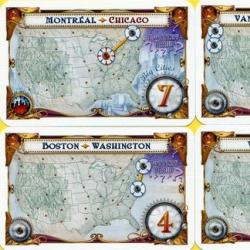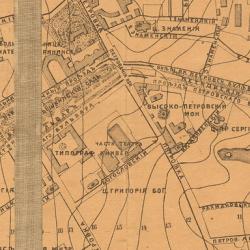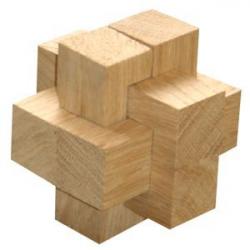How to make wooden puzzles - several interesting options. Cross OSS. Crossroads. Makarov's puzzle. Cube in a cube. Secret cube. The process of making the puzzle “Double Cross Verbal Volleyball” (for junior teams)
All photos from the article
Puzzles are known to develop intelligence, thinking and attentiveness well, so they are recommended for children to solve. True, some of them are not easy to cope with even for adults, who are also not averse to “twirling in their hands” funny details. In this article we will look at how to make some DIY wooden puzzles that will be fun for both children and adults to play with.

General information
First of all, it should be said that making wooden puzzles with your own hands is no less exciting than solving them. Moreover, there is nothing complicated in their manufacture, so anyone can cope with this task.
The only thing is that for this you will need a simple set of tools that every home craftsman has:
- Jigsaw (preferably a jigsaw);
- Chisels;
- Electric drill ;
- Files and needle files;
- Sandpaper.
Advice!
To simplify the task and avoid mistakes in the process of making products, you first need to make drawings of wooden puzzles with your own hands.
As for materials, the most often required are:
- Small boards;
- Bars;
- Sheets of plywood;
- Wood varnish.
Even if these materials are not at hand, they can be purchased at a hardware store. Their price is usually low.

Manufacturing
There are so many options for wooden puzzles for children and adults. Next we will look at the most popular and common of them, which are easy to do yourself.
To make this puzzle, you will need a rail whose width is three times the thickness, for example, if its thickness is 8 mm, then the width should be 24 mm.
The product is made as follows:
- A rail of suitable parameters must be cut into three parts of equal length.
- Next, in each plank you need to cut out a cutout corresponding to its cross section using a jigsaw. As a result, the strips should fit into this hole with little effort. Therefore, it is better for the window to be slightly smaller; in this case, you can bring it to the required parameters using needle files.
- You need to make a cut in the two slats on the side, the width of which should be exactly equal to their thickness. As a result, a T-shaped cut should be obtained in two parts.
- At the end of the work, the parts need to be sanded and varnished.

This completes the puzzle making process.
Now you need to assemble it by following these steps:
- One of the parts with a T-shaped cutout must be inserted into the window, and it must be advanced so much that the end of the side cutout is “flush” with the surface of the strip.
- Next, you should take the third part and put it on top of the bar with the window until it stops.
- After this, you need to push down the first plank with a T-shaped cut all the way.
As a result, the puzzle takes on the appearance of a single piece.

Crossroads
To complete this craft, you will need a 1 cm square block.
The instructions for its manufacture are as follows:
- You need to cut three bars about 8-9 centimeters long from the slats.
- In the middle of one of them, you need to make a cutout 1 cm wide so that you end up with a square jumper with sides of 0.5 cm.
- The second part should be made in exactly the same way, only the jumper should turn out not square, but round.
- In the third block you need to cut a groove 0.5 cm deep and wide.
- Then the same block must be rotated 90 degrees, and another similar groove must be made on the adjacent surface.
- Next, all parts should also be sanded and varnished.
Participants sit in a circle. The presenter invites them to choose one of four phrases: “cross-parallel”, “cross-cross”, “parallel-cross”, “parallel-parallel”. When passing an object, participants say one of the phrases. The presenter answers whether it is true or not, without explaining the reason. The participants' task is to guess what it is.
The secret of the game is as follows: the cross is the participant’s crossed legs, the parallel is the uncrossed legs. For example, the phrase “cross-parallel” means that a person with crossed legs passes a pen to a person with uncrossed legs, etc. and so on.
Bunnies. (to develop attention)
The presenter names a part of the body and shows it on himself. Gradually increases the pace and makes deceptive movements. (Noses, tails, ears, tops.)
Log, path, bridge.
Participants stand in a circle and, turning to one side, begin to move in a circle.
If the leader says the word “log,” then all participants place their hands on the shoulders of the person walking in front. When they hear the word “path,” they walk squatting. When you hear the word “bridge,” they spread their arms to the sides.
Pig game.
The driver is blindfolded, given a stick and placed against the wall (so as not to fall). The rest of the players form a semicircle around him. The driver must touch someone at random with a stick and say: “Piggy, grunt.” The one touched grunts three times without distorting his voice. The driver's task is to concentrate and guess who was grunting. The one he recognizes becomes the driver himself.
I won't answer myself.
The participants of the game stand in a circle, with the leader in the middle. He asks the players various questions, without observing the order. The person asked must remain silent; the neighbor on the right side is responsible for him. The one who answers the question himself or is late to answer for his neighbor leaves the game.
Verbal volleyball (for junior teams)
To play you need a ball. Everyone stands in a circle. Throw the ball through the center of the circle. In this case we call the word a noun. The one who catches the ball adds a verb suitable in meaning, for example: a cloud - floats, a fire - burns. The one who says nonsense is out of the game.
Seeker.
Prepare some small object: a thimble, a ring, a pen, a badge. All players except the leader leave the room. The presenter places the item in the most visible place. Invite the players one by one and explain that you can only make one lap around the room. If he finds an object with his gaze, he sits down; if not, he leaves the room again.
To yourself - to your neighbor.
The players stand in a circle, their arms extended. The leader stands in the center. The players have one hand motionless, and with the other they pass the coin in any direction in a circle, placing it on the palm of their neighbor. Everyone makes a hand movement at the same time, regardless of whether there is a coin there or not. At the same time they say: “To themselves - to their neighbor.” The presenter must guess who has the coin.
Three are active.
The room must remain completely silent. Three players are blindfolded. Everyone must catch one of the partners and escape from the other. The participants in the game listen to each other’s steps, breathing and, when they consider it necessary, call the player by name and ask: “Where are you?” The player who is asked must immediately answer: “I’m here!” The first one who manages to catch the “enemy” becomes the winner. After this, three others begin to play.
Half a word is yours.
The participants of the game sit in a circle and throw the ball to each other. In this case, those who throw say half of a word; the one who catches must name its other half, for example: locomotive, telephone. You need to answer quickly. For each mistake or delay, the participant is eliminated from the game. The condition can be complicated: the leader says half the word to each child sitting in a circle, and everyone must continue the second half. Can't - penalty point. The presenter begins to say his half of the word, for example: “Tele...”. Children continue: telephone, telegram, telescope, cart, etc. It is better to play this game in the middle and junior teams.
The exercises proposed below can be carried out as full-fledged fires. It should be good to go in the middle of a shift, when you become “tired” from the impressions and want to go home, and by this time the situation in the detachment may become “heated up”.
07.05.2013.
Knots of six bars.
I think I will not be mistaken if I say that the knot of six bars is the most famous wooden puzzle.
There is an opinion (and I completely share it!) that wooden knots were born in Japan, as an improvisation on the theme of traditional local building structures. This is probably why modern residents of the Land of the Rising Sun are unsurpassed puzzlers. In the best sense of the word.
About ten years ago, armed with a rental machine that is unique to this day, “Skillful Hands,” for children’s creativity, I made many versions of six-bar knots from oak and beech...


Regardless of the complexity of the original components, in all versions of this puzzle there is one straight, uncut block that is always inserted into the structure last and closes it into an inseparable whole.
The pages below from the already mentioned book by A.S. Pugachev show the variety of units of six bars and provide comprehensive information for their independent manufacture.




Among the options presented, some are very simple, and some are not so simple. Somehow it happened that one of them (in Pugachev’s book it appears as number 6) received its own name - “The Cross of Admiral Makarov.”
Knot of six bars - Puzzle "Cross of Admiral Makarov".
I won’t go into details why it’s called that - either because the glorious admiral, in the lulls between naval battles, loved to make it in ship’s carpentry, or for some other reason... I’ll just say one thing - this option is really difficult, despite the fact that the details lack the “internal” notches that I so dislike. It’s too inconvenient to pick them out with a chisel!


The pictures below, created using the Autodesk 3D Max three-dimensional modeling program, show the appearance of the parts and the solution (sequence and spatial orientation) of the "Admiral Makarov's Cross" puzzle.


| In computer graphics classes at Children's Art School No. 2, among other miscellaneous things, I also use mock-up puzzles made “in haste” from polystyrene foam as teaching aids. For example, the details of a cross made of six bars are excellent as a “lifestyle” for low-poly modeling.
A simple knot of three bars will be useful for understanding the basics of key animation.
| ||
Among other things, in the same book by A.S. Pugachev there are drawings of other units, including those made of twelve and even sixteen bars!
A knot of sixteen bars.

Even though there are a lot of parts, this puzzle is quite simple to assemble. As in the case of six-bar units, the last part to be inserted is a straight piece without cutouts.


|
DeAgostini
Magazine "Entertaining Puzzles" No. 7, 10, 17
Issue No. 7 of the magazine "Entertaining Puzzles" of the publishing house "DeAgostini" presents a rather interesting, in my opinion, puzzle "Oblique Knot".
It is based on a very simple knot of three elements, but due to the “bending”, the new version has become much more complex and interesting. In any case, my students at art school sometimes twist and turn it, but cannot put it together... And by the way, when I decided to model it in 3D Max, I suffered quite a bit... The screenshot below from the magazine shows the assembly sequence of the "Oblique Knot"
The “Barrel Puzzle” puzzle from issue 17 of the “Entertaining Puzzles” magazine is very similar in its internal essence to the “Knot of Sixteen Bars” presented on this page.
Yes, I would like to take this opportunity to note the high quality of production of almost all the puzzles I purchased from the DeAgostini publishing house. In some cases, however, I had to pick up a file and even glue, but that’s just it... costs. The process of assembling the Barrel Puzzle is shown below.
I can’t help but say a few words about the very original “Cross Puzzle” from the same “Entertaining Puzzles” series No. 10. In appearance, it looks like it’s also a cross (or a knot), made of two bars, but to separate them, you don’t need a smart head, but strong arms. I mean, you need to quickly spin the puzzle like a top on a flat surface, and it will figure it out!
The fact is that the cylindrical pins locking the assembly, under the influence of centrifugal force, diverge to the sides and open the “lock”. Simple, but tasteful!
| ||



















